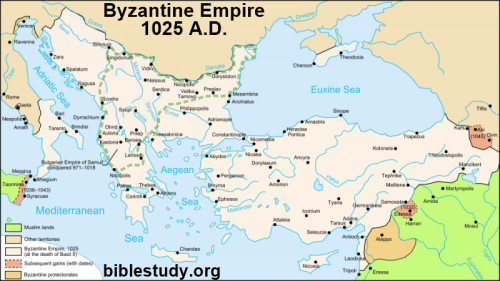The foundation for the beginning of the Byzantine Empire was laid in 285 A.D. when Emperor Diocletian made Maximian a co-emperor (Caesar) in order to share the weight of governing. Diocletian took the responsibility of governing the eastern lands while Maximian was responsible for its western section.
Both Diocletian and Maximian, in 305 A.D., retire as Emperors. In their place they make Constantius (Chlorus) rule over the western lands while Galerius is given power to rule the eastern provinces. Constantius' sudden death in 306, however, makes it possible for his son Constantine the Great to rule when Galerius recognizes him as Caesar. History will ultimately consider Constantine the first Byzantine Emperor. In 330 he makes Byzantium (later Constantinople) his imperial capital.
Influence
Emperor Constantine's influence on the history of Christianity is significant. Rome, from the time of Nero in 67 A.D., had carried out waves of harassment and persecution against those who believed in the Bible. Constantine's 313 A.D. Edict of Milan, however, officially ended more than two centuries of violence against Christians by legalizing the religion. His action eventually led to Christianity becoming the official state religion in 380.

Permanent split
Emperor Theodosius I, in 379 A.D., began his reign over the eastern part of the empire. He assumes, in 394, control over Rome's western lands, becoming the last ruler to wield power over a united kingdom. In 395, upon his death, the kingdom splits permanently into two parts. The western part controlled by Rome exists only until 476 A.D. when Heruli General Odoacer forces Emperor Romulus Augustus to abdicate. The eastern or Byzantine Empire, however, continues to exist for hundreds of years.
Overview
The Byzantine economy was, for several centuries, one of the most advanced and prosperous in the world. This was mainly due to Constantinople's strategic location at a point where Europe meets Asia. It functioned as one of the primary ports for the famous Silk Road (route that facilitated trade between China, India, Egypt and Europe) which made it a wealthy economic hub.
A Roman Catholic perspective on the history of this world power states the following.
"The whole of Byzantine history is the record of struggles between a civilized state and wild, or half-civilized, neighboring tribes. Again and again was the Byzantine Empire de facto reduced to the limits of the capital city, which Anastasius had transformed into an unrivaled fortress; and often, too, was the victory over its foes gained by troops before whose ferocity its own citizens trembled" (1913 Catholic Encyclopedia).
Noteworthy
Emperor Justinian I reigned from 527 to 565 A.D. His rule is especially noteworthy because, unlike his predecessors, was able to reconquer many of the Western Empire's former lands such as Italy, Africa and southern Hispania (Spain).
Justinian and the Byzantine Empire also fulfilled prophecy. The mighty Romans and its successor kingdoms are represented by the two legs of iron seen in Nebuchadnezzar's dream of a large statue (Daniel 2:33, 40 - 43). They are also represented by Daniel's dream of a powerful beast with teeth of iron and ten horns (Daniel 7:7, 23 - 24). Emperor Justinian I's partial restoration of Rome's power, starting in 527 A.D., is the fourth of ten horns witnessed by Daniel.
Decline
Around 1071 A.D., after years of dominance, Constantinople lost most of its heartland (Asia Minor) to the Seljuk Turks. It received a mortal blow in 1204 by the Fourth Crusade, when it was dissolved and divided into competing Greek and Latin realms. Despite the re-establishment of Constantinople's power in 1261, under the Palaiologan emperors, successive civil wars in the 14th century further sapped its strength.
Downfall
The Byzantine Empire exists as a world power from 395 to 1204 A.D. and from 1261 to 1453. The Catholic Encyclopedia states the following about its downfall.
"After some preliminary victories, however, defeat ensued near Varna, 1444. The quarrels of various pretenders to the throne and the lack of unity among those in power within the city (Constantinople) precipitated the final catastrophe. On 29 May, 1453, the (Ottoman) Turks captured Constantinople and seven years later (1460) the last remnant of the (Byzantine) empire, the principalities on the Peloponnesus" (ibid.).
From the time of Augustus who, in 27 B.C., arguably became the first Emperor, to the fall of the Byzantine capital in 1453 A.D., Roman power (in one form or another) existed for more than 1,450 years!